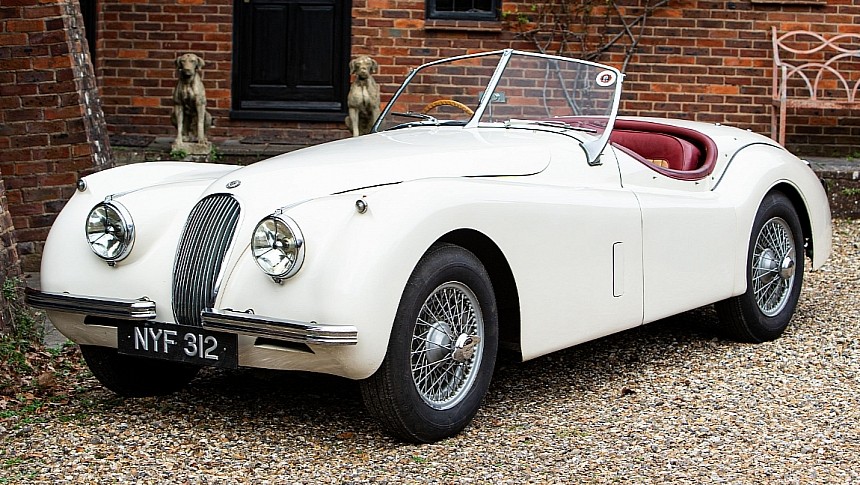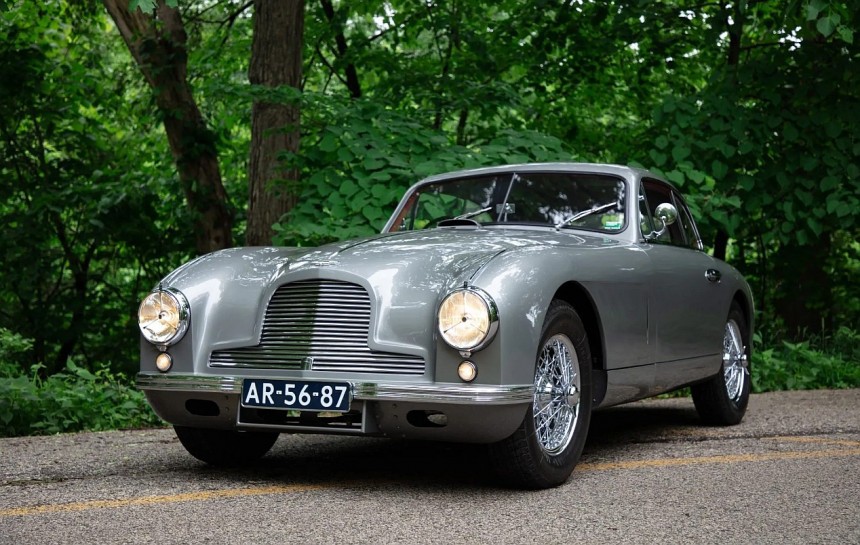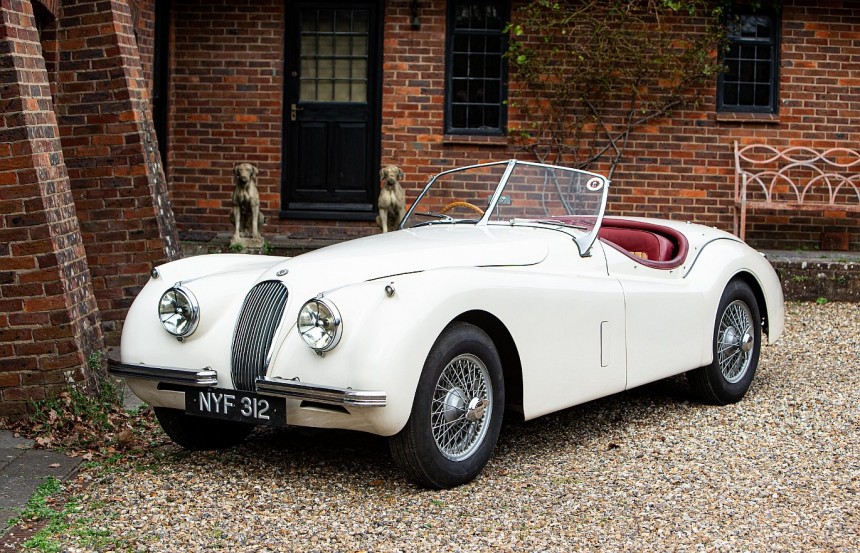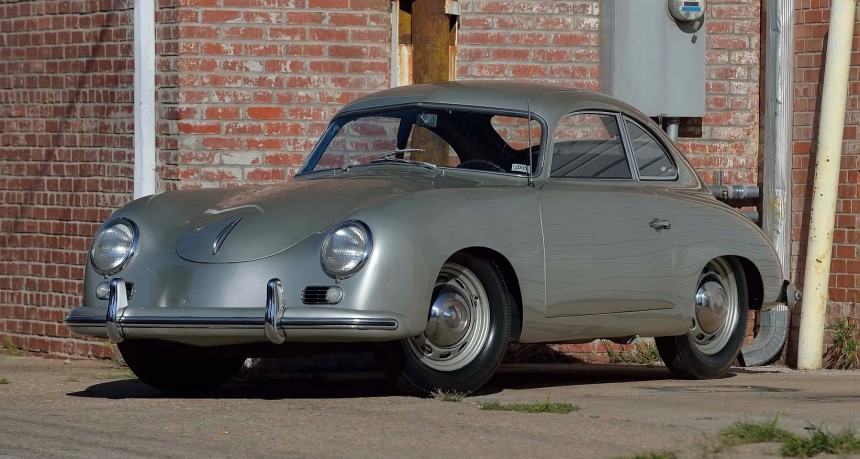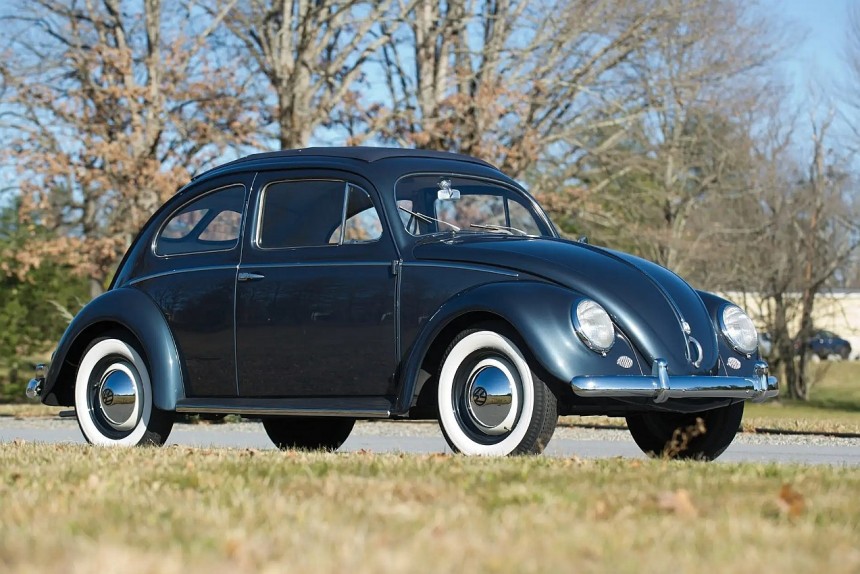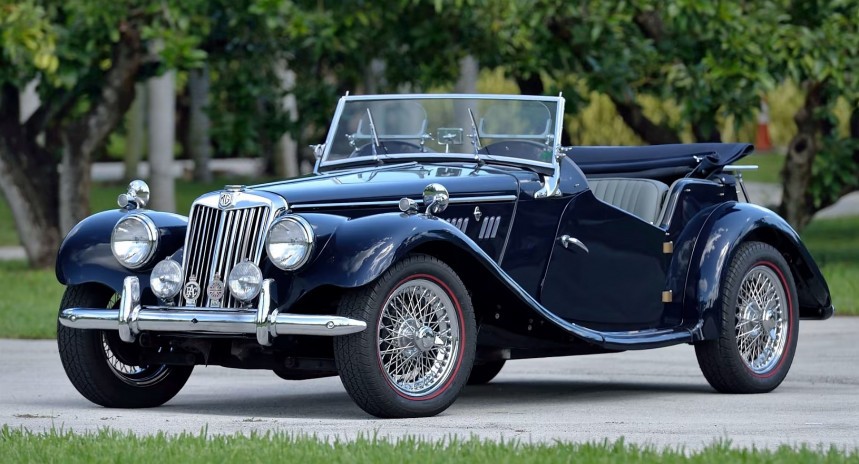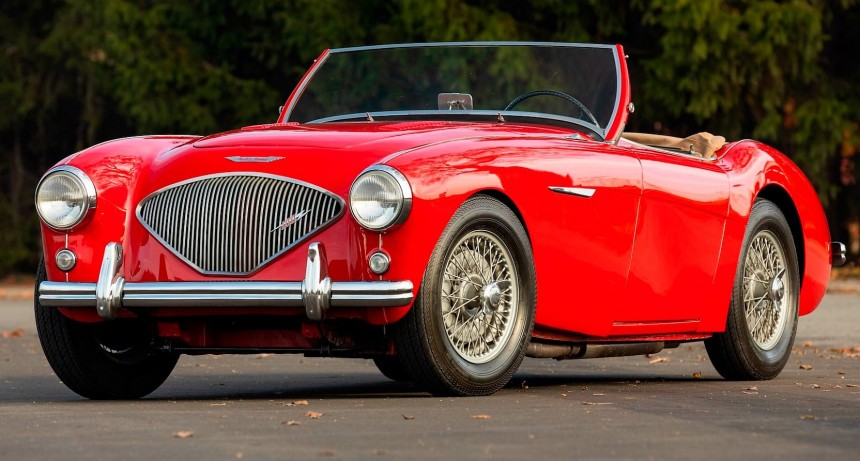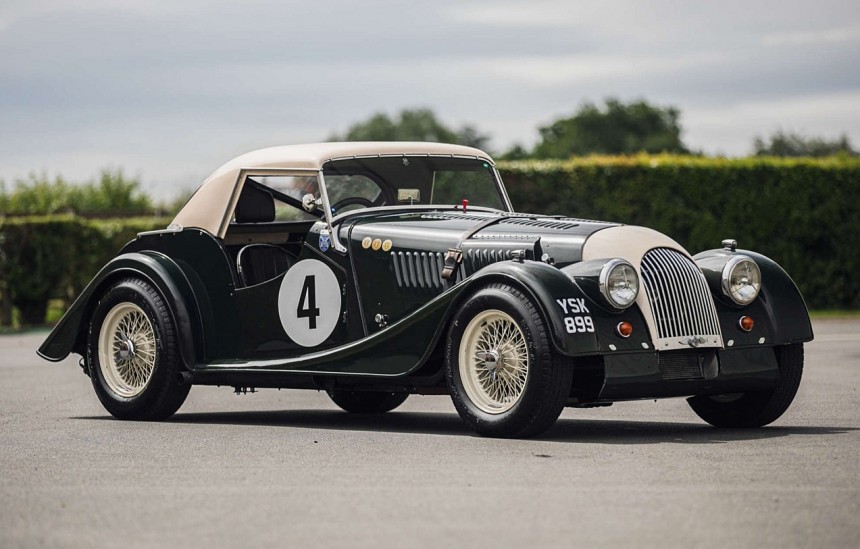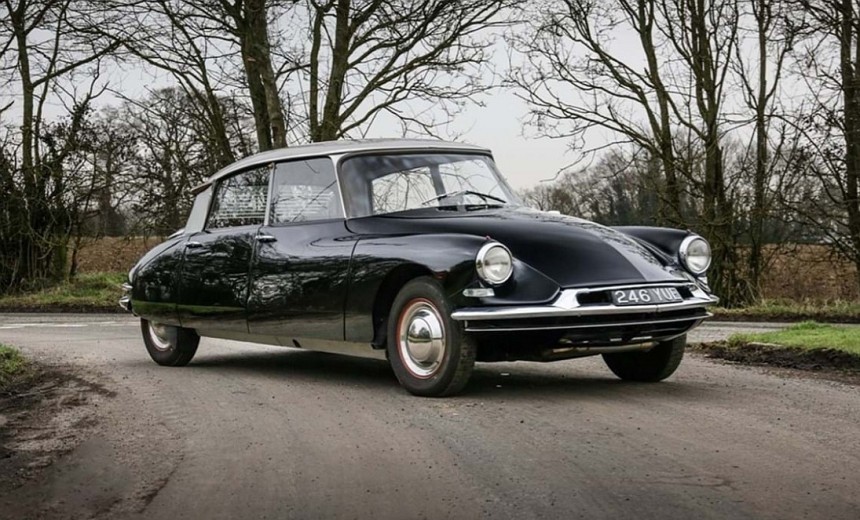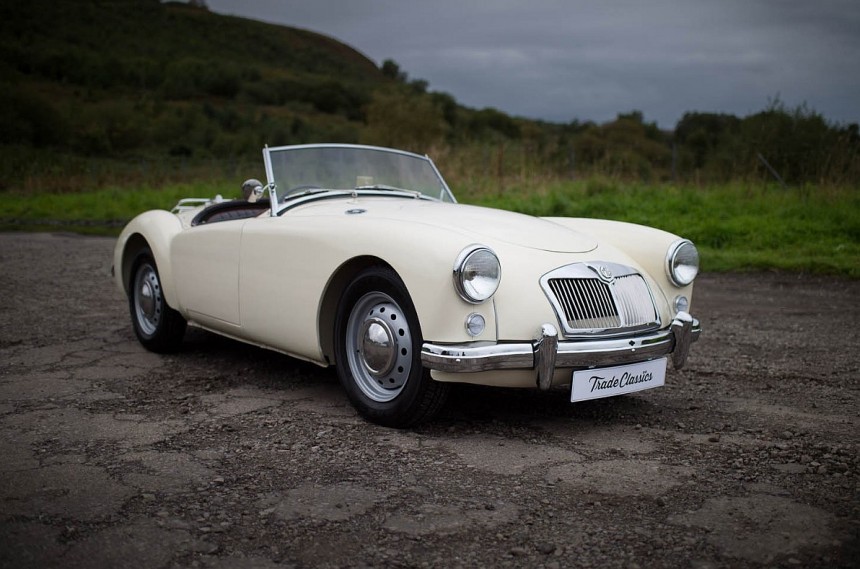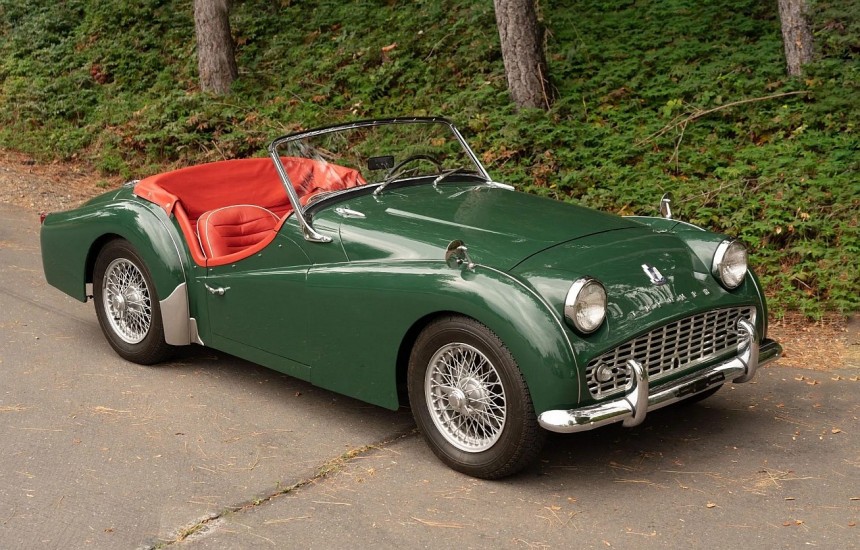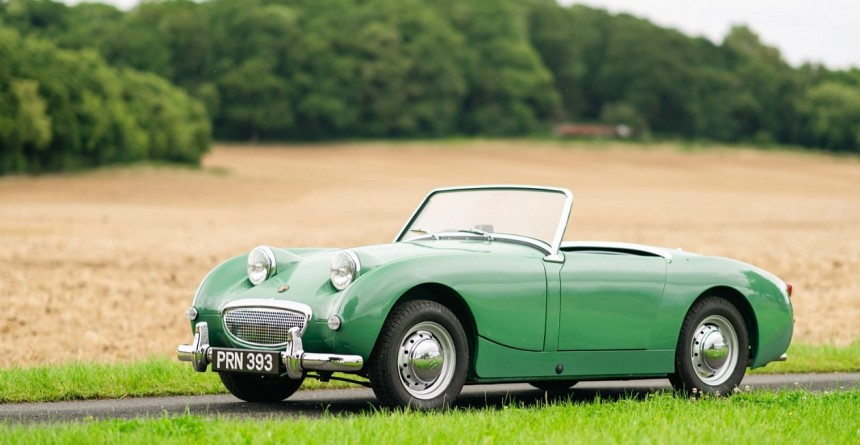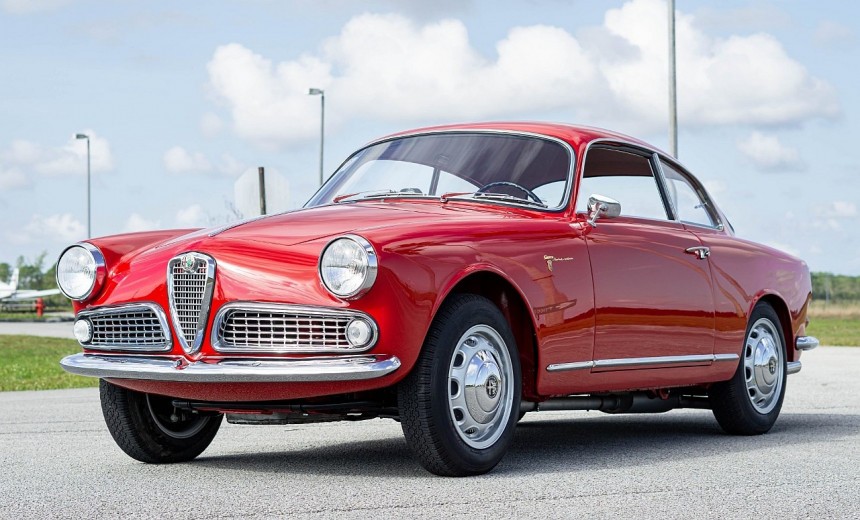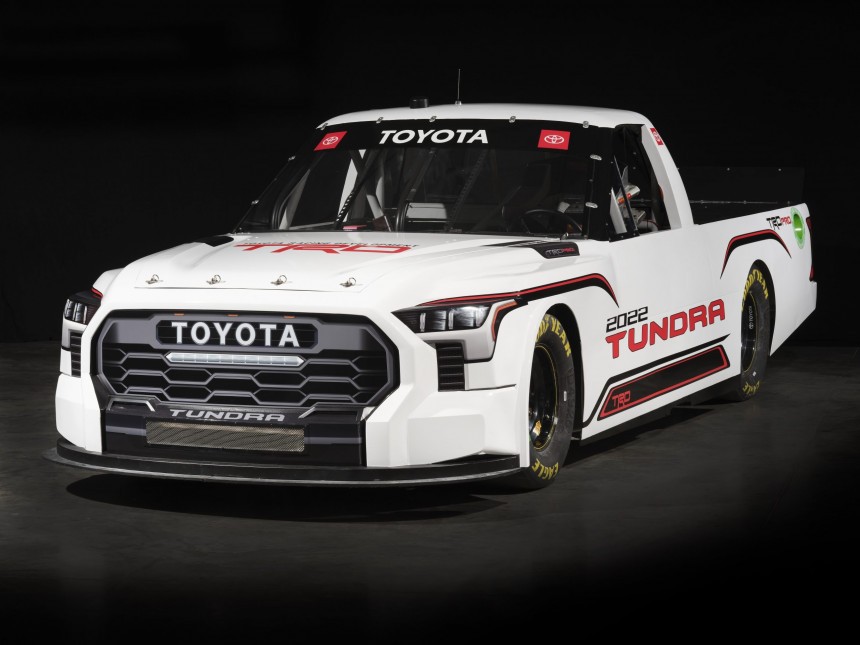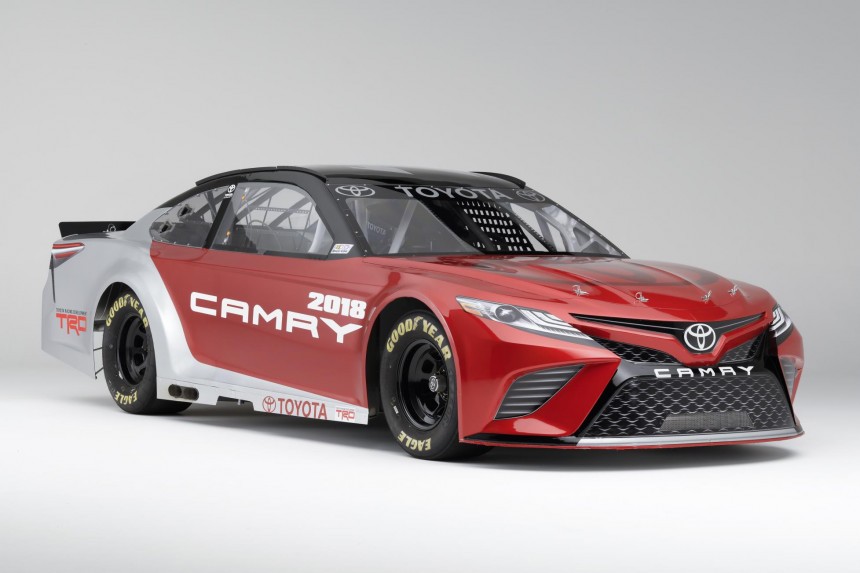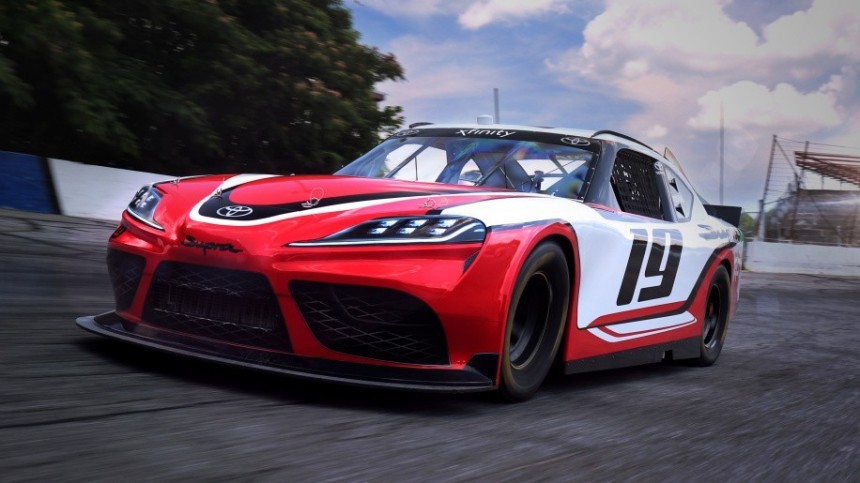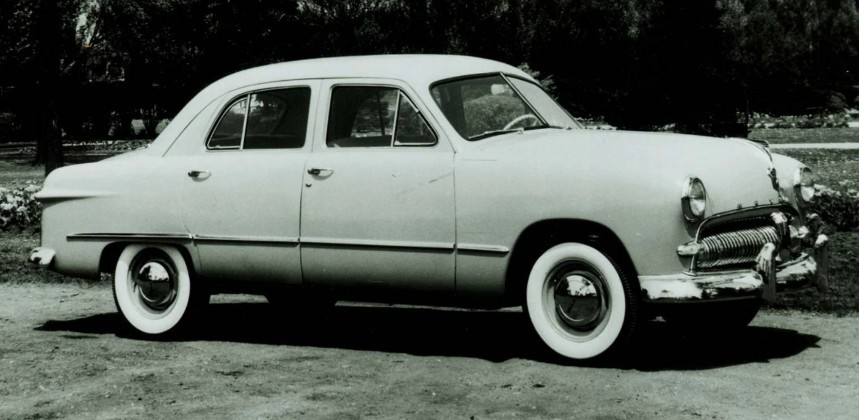Founded in 1948 by Bill France Sr., NASCAR has been an all-American affair until Toyota got involved in the 2000s. But many people don't know that some European cars found their way on Cup Series tracks throughout the years.
It started in the 1950s, a few years after NASCAR became a motorsport organization and at a time when stock car racing was still about stock cars. These occasional appearances lasted until 1963 and included automobiles produced by British, German, French, and Italian automakers.
So, while Toyota was the first foreign company to join NASCAR full-time, other non-US carmakers went against the Detroit-built tide on the road and oval courses. The likes of Jaguar, Porsche, and MG did it in the early years of the series.
According to most sources, an Aston Martin was among the first foreign cars raced in NASCAR. It happened in 1953, the fifth Cup Series championship, at the International 200. Raced at Langhorne Speedway in Pennsylvania, the event gathered 38 cars at the starting line.
The grid was dominated by Hudson Hornets and Oldsmobile 88s, but Chevrolets, Dodges, and Lincolns also contested the race. It wasn't an all-American affair, though, as no fewer than ten cars were foreign. Among them was an Aston Martin driven by Steve McGrath.
Unfortunately, there's next to no info about Steve's No. 1 entry beyond the fact that he qualified 16th and finished the race 27th. There's no info about the sponsor and owner of the car either. In fact, sources don't even mention what type of Aston Martin he drove that day.
The British company was selling two models in 1953. The DB2 was on its way out after a three-year run, while the updated DB2/4 was stepping in with a revised appearance and an upgraded engine. The latter had only been available for two months at the time of the race, so I guess it's safe to assume McGrath was driving a DB2.
There's no evidence of another Aston Martin entry in 1953 (or any other year), so the International 200 was the carmaker's sole venture into NASCAR racing. Earlier that year, McGrath raced a Hudson Hornet at North Wilkesboro and Charlotte race tracks.
The rather mysterious Aston Martin wasn't the only European car that competed against American iron at the International 200. The road course event also saw Jaguars, Porsches, and Volkswagens line up for a piece of NASCAR Grand National glory. No fewer than six Jaguar XK120s contested the race with American and Canadian drivers behind the wheel.
Dick Allwine was the quickest and finished the race sixth, some 16 laps behind Dick Rathmann, who took the win in a 1953 Hudson Hornet. Charlie Miller and Frankie Schneider were classified as 11th and 12th.
Unlike Aston Martins, Jaguars returned to NASCAR racing through 1956. Naturally, drivers preferred road course events where the lighter and more nimble XK120 had an advantage over the powerful yet heavy American rigs.
This strategy came to fruition at the 1954 International 100 at Linder Airport, New Jersey. No fewer than four Jaguars finished in the Top 6, with Al Keller winning the race a full lap ahead of Joe Eubanks' Hudson Hornet and Buck Baker's Oldsmobile 88. A total of 12 Jaguars contested the race. And of the 43 cars that started roaring at the green light, 20 were foreign.
Built from 1948 to 1954 in some 12,000 units, the Jaguar XK120 is the only European car to have won a NASCAR race. It was also the only foreign automobile to win a Cup Series event until Toyota scored its first victory in 2008.
A rare sight even at road course events, the 356 returned during the 1954 season and participated in the International 100 at Linden Airport. A single Porsche was fielded in that race. Driven by James Kilgore, it finished 16th, five laps behind the winning Jaguar XK120.
I also found some info that a 356 may have been raced at Langhorne Speedway in 1951. Race statistics do not list a Porsche 356, but word has it a gentleman named Edgar Otto Sr. prepared a German coupe for the said race. If true, the Porsche 356 was the first foreign vehicle to race in NASCAR.
Although it failed to win against American competition, the 356 was a very successful race car. Notable achievements include class wins at the 24 Hours of Le Mans, Targa Florio, 12 Hours of Sebring, and 12 Hours of Reims.
Introduced as a prototype in 1931 and put into mass production in 1940, the Beetle is one of the best-selling automobiles of all time, with more than 20 million units delivered through 2003. It's not the first vehicle that comes to mind when discussing race cars, but the Beetle was entered in the Trans-Am series in the 1960s.
The tiny "people's car" also made a brief appearance in NASCAR, with a single example raced in the same 1953 International 200 event that also saw Aston Martin, Jaguar, and Porsche join the series. Driven by Dick Hagy, the underpowered Beetle finished the race in 19th. It remains the only Beetle to run in a NASCAR Grand National event.
The T-type made its sole NASCAR appearance at the 1954 International 100 at Linden Airport, the race famously won by the Jaguar XK120. At the time, the Midget had been upgraded to TF specifications with a larger, 1.5-liter mill good for 63 horsepower.
Five MGs shared the track with other European automobiles, including Jaguars, Porsches, Austin Healeys, and a Morgan. Even though it didn't pose a threat to the Jaguars and Hudsons, the MGs faired well, and the car driven by Tom Rivers finished 14th, five laps behind the winner. Four of the five T-types finished the event.
The brand started with the 100, a sports car based on the Austin A90 underpinnings and developed from the Nash-Healey. It was introduced in 1953 and remained in production until 1956 with 2.7-liter four-cylinder engines.
Two cars entered the 1954 International 100 at Linden Airport and finished 12th and 13th, four laps behind the winning Jaguar XK120. They were driven by Earl Beer and Phillips Bell.
Morgan, now there's a name you wouldn't expect to find on a NASCAR results list. Especially since this brand was never popular in the United States. But the British brand is among the European carmakers that competed in the series thanks to a single appearance at the 1954 International 100.
The car driven by Jack Farnell didn't last long, though, as a mechanical issue forced the American to retire after only ten laps. There's no info on sponsorship and the actual model, but Morgan offered only one vehicle at the time: the Plus 4 roadster. So unless Farnell drove an older 4/4 (discontinued in 1950), Morgan's sole NASCAR contender was a first-gen Plus 4 (1950-1969)
The only French car known to have entered NASCAR, the ID-19 made a brief appearance during the 1958 season. Sponsored by the Citroen Cars Corporation that imported vehicles in the US, the ID-19 entries tackled the Crown America 500 at Riverside Raceway.
Driven by Bill Jones and Ralph Roberts, the French cars finished 18th and 19th, 30 laps behind the winner. The result is rather impressive, given that the 46-car grid was made entirely from American vehicles.
Unfamiliar with the ID-19? Well, it was a subseries of the more iconic DS. Developed as a more affordable version of the latter, the ID-19 was produced from 1957 to 1969. Early cars came with 1.9-liter four-cylinder engines rated at 69 horsepower.
The Midget (T-type) wasn't the only MG that competed in NASCAR. Its successor, the MGA, also raced against America's high-power rigs. Unfortunately, info on the MGA's NASCAR stint is limited and contradictory.
While some sources claim that the British car raced in the Grand National Series from 1960 to 1963, the MGA is not included in period statistics for the 1960 season.
But the MG MGA is known to have raced at the International 200 at Bowman-Gray Stadium in both 1962 and 1963. In 1962, four MGs joined the event, with Robert Berrier's 15th position as the best result.
Only one MGA entered the 1963 race. The car driven by Smokey Cook, a small-time driver, started next to last and retired due to overheating after only 12 laps.
What we do know for a fact is that the MG MGA was the last foreign vehicle to compete in NASCAR until Toyota joined the series in the 2000s.
The model isn't specified, but the British company was offering only one car that year, the TR3. The same race saw Smokey Cook retire in a 1952 MG after only one lap.
Launched in 1955 as a replacement for the TR2, the TR3 was a traditional roadster powered by small-displacement four-cylinder units. The engine lineup included 2.0- and 2.1-liter mills rated at 95 and 100 horsepower, respectively.
While it failed to make an impression in NASCAR, the TR3 was a reliable and successful race car in Europe, achieving numerous outright, team, and class victories in road, rally, and hillclimb events.
Arguably the most iconic Austin-Healey ever made, the Sprite is mainly famous for its bug-eyed front fascia. But while it wasn't the prettiest sports car of its era, the Sprite had a successful motorsport career, which included a 12th-place finish at the 1965 24 Hours of Le Mans.
The Sprite made a brief appearance in NASCAR in 1961 when three cars were entered in the third seasonal event at Bowman Gray Stadium. The 1960 Sprite driven by Doc Lee finished 15th, while the 1958 model driven by Jack Hart retired after 58 laps. The third Sprite, a 1960 version driven by Paul Lyons, quit after only four laps.
The Sprites returned to Winston-Salem with similar results in 1962. Herbert Scott's car was classified 17th, followed by Doug Duvall's No. 21 racer. Paul Lyons retired again after nine laps.
It's unclear if Bill's Giulietta was a late 1950s or early 1960s car. The first-gen Giulietta was produced from 1954 to 1965 and spawned numerous iterations. While the base Berlina came with 52 horsepower on tap, the sportier Sprint Veloce had an 89-horsepower engine. Alfa Romeo also produced a Sprint Special variant with 99 horses.
While most of the cars above were entered as private efforts, Toyota has a full-blown racing program that includes not only the Cup Series, but also the Xfinity and the Truck categories. The latter was the first to welcome the Japanese carmaker, which joined the series with a Tundra lookalike in 2004.
Toyota won its first race at Michigan International Speedway in its maiden year and the first manufacturer championship in 2006. The Japanese outfit scored five consecutive titles from 2006 to 2010 and five more from 2013 to 2017. Three more championships followed in 2019, 2021, and 2022.
In all, Toyota won 13 of 28 championships since it joined the Truck Series, a record. Chevrolet has ten titles, while Dodge and Ford won three and two seasons, respectively.
Following its success in the Truck Series, Toyota tackled the premier Cup Series with the Camry. The outfit struggled in its first season and didn't score its first win until March 2008. Toyota's first championship came in 2016. It was the first Cup Series title won by a foreign automaker, ending Chevrolet's 13-season record streak.
The Japanese carmaker scored its second championship in 2017, this time around also clinching the driver's title through Martin Truex Jr. The third trophy followed in 2019.
With 179 race wins as of September 2023, Toyota is the fifth-most-winningest automaker. Chevrolet leads the pack with 847 wins, while Ford comes second with 726 victories. Dodge, which retired from the sport in 2012, has 217 wins. The fourth position goes to Plymouth with 191 victories, the last of which was scored in 1973.
Toyota also used the Camry to race in the Xfinity Series starting in 2007. And it won four championships until 2019, when it replaced the Camry with the Supra, which had just returned to showrooms as a production model. The latter has yet to clinch a manufacturers' title for Toyota, but it gave the Japanese carmaker the drivers' championship in 2021 and 2022.
Overall, Toyota scored 21 championship wins in all three series across 19 seasons, which makes it the third most successful NASCAR manufacturer. It's also one of only nine carmakers that won at least one championship regardless of series.
Meteor cars were based on US-made Ford models until 1961, when the brand was discontinued to make way for the Mercury Meteor nameplate. When the latter was retired in 1963, the Meteor marque returned and offered a lineup of Mercury-based full-size cars.
A 1950 Meteor of unknown nameplate was raced in NASCAR at the Monroe County Fairgrounds in Rochester, New York, on July 3, 1953. Run against an all-American grid with Canadian driver Leo Bergeron behind the wheel, the Meteor finished 14th. The model year suggests it was a Deluxe or Custom model.
So, while Toyota was the first foreign company to join NASCAR full-time, other non-US carmakers went against the Detroit-built tide on the road and oval courses. The likes of Jaguar, Porsche, and MG did it in the early years of the series.
Aston Martin (1953)
The grid was dominated by Hudson Hornets and Oldsmobile 88s, but Chevrolets, Dodges, and Lincolns also contested the race. It wasn't an all-American affair, though, as no fewer than ten cars were foreign. Among them was an Aston Martin driven by Steve McGrath.
Unfortunately, there's next to no info about Steve's No. 1 entry beyond the fact that he qualified 16th and finished the race 27th. There's no info about the sponsor and owner of the car either. In fact, sources don't even mention what type of Aston Martin he drove that day.
The British company was selling two models in 1953. The DB2 was on its way out after a three-year run, while the updated DB2/4 was stepping in with a revised appearance and an upgraded engine. The latter had only been available for two months at the time of the race, so I guess it's safe to assume McGrath was driving a DB2.
There's no evidence of another Aston Martin entry in 1953 (or any other year), so the International 200 was the carmaker's sole venture into NASCAR racing. Earlier that year, McGrath raced a Hudson Hornet at North Wilkesboro and Charlotte race tracks.
Jaguar XK120 (1953-1956)
Dick Allwine was the quickest and finished the race sixth, some 16 laps behind Dick Rathmann, who took the win in a 1953 Hudson Hornet. Charlie Miller and Frankie Schneider were classified as 11th and 12th.
Unlike Aston Martins, Jaguars returned to NASCAR racing through 1956. Naturally, drivers preferred road course events where the lighter and more nimble XK120 had an advantage over the powerful yet heavy American rigs.
This strategy came to fruition at the 1954 International 100 at Linder Airport, New Jersey. No fewer than four Jaguars finished in the Top 6, with Al Keller winning the race a full lap ahead of Joe Eubanks' Hudson Hornet and Buck Baker's Oldsmobile 88. A total of 12 Jaguars contested the race. And of the 43 cars that started roaring at the green light, 20 were foreign.
Built from 1948 to 1954 in some 12,000 units, the Jaguar XK120 is the only European car to have won a NASCAR race. It was also the only foreign automobile to win a Cup Series event until Toyota scored its first victory in 2008.
Porsche 356 (1953-1954)
The predecessor to the more iconic 911, the Porsche 356 also debuted at the 1953 International 200. Only two cars joined the event, finishing in the Top 10. Nick Fornoro raced his mostly stock 356 to eighth place, about 19 laps behind the winning Hudson Hornet. Billy Oswald crossed the line ninth, seven laps behind Fornoro.A rare sight even at road course events, the 356 returned during the 1954 season and participated in the International 100 at Linden Airport. A single Porsche was fielded in that race. Driven by James Kilgore, it finished 16th, five laps behind the winning Jaguar XK120.
I also found some info that a 356 may have been raced at Langhorne Speedway in 1951. Race statistics do not list a Porsche 356, but word has it a gentleman named Edgar Otto Sr. prepared a German coupe for the said race. If true, the Porsche 356 was the first foreign vehicle to race in NASCAR.
Although it failed to win against American competition, the 356 was a very successful race car. Notable achievements include class wins at the 24 Hours of Le Mans, Targa Florio, 12 Hours of Sebring, and 12 Hours of Reims.
Volkswagen Beetle (1953)
The tiny "people's car" also made a brief appearance in NASCAR, with a single example raced in the same 1953 International 200 event that also saw Aston Martin, Jaguar, and Porsche join the series. Driven by Dick Hagy, the underpowered Beetle finished the race in 19th. It remains the only Beetle to run in a NASCAR Grand National event.
MG T-type / Midget (1954)
More commonly known as the Midget, the T-type was a series of cars produced by British carmaker MG from 1936 to 1955. The open-top sports car lineage began with the TA Midget and included the TB, TC, TD, and TF as updates. All cars were powered exclusively by four-cylinder engines. And even though it wasn't particularly potent, the Midget was favored by racers for its lightweight construction.The T-type made its sole NASCAR appearance at the 1954 International 100 at Linden Airport, the race famously won by the Jaguar XK120. At the time, the Midget had been upgraded to TF specifications with a larger, 1.5-liter mill good for 63 horsepower.
Five MGs shared the track with other European automobiles, including Jaguars, Porsches, Austin Healeys, and a Morgan. Even though it didn't pose a threat to the Jaguars and Hudsons, the MGs faired well, and the car driven by Tom Rivers finished 14th, five laps behind the winner. Four of the five T-types finished the event.
Austin-Healey 100 (1954)
The same International 100 saw the first Austin-Healey sports car enter NASCAR. A brand-new company at the time, Austin-Healey was set up in 1952 through a joint venture between the Austin division of the British Motor Corporation and the Donald Healey Motor Company. Austin-Healey developed only four models until it disappeared in 1971.The brand started with the 100, a sports car based on the Austin A90 underpinnings and developed from the Nash-Healey. It was introduced in 1953 and remained in production until 1956 with 2.7-liter four-cylinder engines.
Two cars entered the 1954 International 100 at Linden Airport and finished 12th and 13th, four laps behind the winning Jaguar XK120. They were driven by Earl Beer and Phillips Bell.
Morgan (1954)
The car driven by Jack Farnell didn't last long, though, as a mechanical issue forced the American to retire after only ten laps. There's no info on sponsorship and the actual model, but Morgan offered only one vehicle at the time: the Plus 4 roadster. So unless Farnell drove an older 4/4 (discontinued in 1950), Morgan's sole NASCAR contender was a first-gen Plus 4 (1950-1969)
Citroen ID-19 (1958)
Driven by Bill Jones and Ralph Roberts, the French cars finished 18th and 19th, 30 laps behind the winner. The result is rather impressive, given that the 46-car grid was made entirely from American vehicles.
Unfamiliar with the ID-19? Well, it was a subseries of the more iconic DS. Developed as a more affordable version of the latter, the ID-19 was produced from 1957 to 1969. Early cars came with 1.9-liter four-cylinder engines rated at 69 horsepower.
MG MGA (1960-1963)
While some sources claim that the British car raced in the Grand National Series from 1960 to 1963, the MGA is not included in period statistics for the 1960 season.
But the MG MGA is known to have raced at the International 200 at Bowman-Gray Stadium in both 1962 and 1963. In 1962, four MGs joined the event, with Robert Berrier's 15th position as the best result.
Only one MGA entered the 1963 race. The car driven by Smokey Cook, a small-time driver, started next to last and retired due to overheating after only 12 laps.
What we do know for a fact is that the MG MGA was the last foreign vehicle to compete in NASCAR until Toyota joined the series in the 2000s.
Triumph (1960)
Yet another one-time entry that we don't know much about, Triumph had its name on the grid at the 1960 International 200. The race was held at Bowman-Gray Stadium and included a small 18-car lineup. Jack Hart reportedly drove a 1957 Triumph.The model isn't specified, but the British company was offering only one car that year, the TR3. The same race saw Smokey Cook retire in a 1952 MG after only one lap.
Launched in 1955 as a replacement for the TR2, the TR3 was a traditional roadster powered by small-displacement four-cylinder units. The engine lineup included 2.0- and 2.1-liter mills rated at 95 and 100 horsepower, respectively.
While it failed to make an impression in NASCAR, the TR3 was a reliable and successful race car in Europe, achieving numerous outright, team, and class victories in road, rally, and hillclimb events.
Austin-Healey Sprite (1961-1962)
The Sprite made a brief appearance in NASCAR in 1961 when three cars were entered in the third seasonal event at Bowman Gray Stadium. The 1960 Sprite driven by Doc Lee finished 15th, while the 1958 model driven by Jack Hart retired after 58 laps. The third Sprite, a 1960 version driven by Paul Lyons, quit after only four laps.
The Sprites returned to Winston-Salem with similar results in 1962. Herbert Scott's car was classified 17th, followed by Doug Duvall's No. 21 racer. Paul Lyons retired again after nine laps.
Alfa Romeo Giulietta (1962)
The Sprite's final NASCAR appearance was also the only one for the Alfa Romeo Giulietta. The only Italian car ever raced on a NASCAR track, the Giulietta was driven by Bill Block. The American lapped the stadium only 32 times before retiring due to mechanical issues. He was classified 22nd out of 24 competitors.It's unclear if Bill's Giulietta was a late 1950s or early 1960s car. The first-gen Giulietta was produced from 1954 to 1965 and spawned numerous iterations. While the base Berlina came with 52 horsepower on tap, the sportier Sprint Veloce had an 89-horsepower engine. Alfa Romeo also produced a Sprint Special variant with 99 horses.
Toyota Tundra (2004-present)
Toyota won its first race at Michigan International Speedway in its maiden year and the first manufacturer championship in 2006. The Japanese outfit scored five consecutive titles from 2006 to 2010 and five more from 2013 to 2017. Three more championships followed in 2019, 2021, and 2022.
In all, Toyota won 13 of 28 championships since it joined the Truck Series, a record. Chevrolet has ten titles, while Dodge and Ford won three and two seasons, respectively.
Toyota Camry (2007-present)
The Japanese carmaker scored its second championship in 2017, this time around also clinching the driver's title through Martin Truex Jr. The third trophy followed in 2019.
With 179 race wins as of September 2023, Toyota is the fifth-most-winningest automaker. Chevrolet leads the pack with 847 wins, while Ford comes second with 726 victories. Dodge, which retired from the sport in 2012, has 217 wins. The fourth position goes to Plymouth with 191 victories, the last of which was scored in 1973.
Toyota Supra (2019-present)
Overall, Toyota scored 21 championship wins in all three series across 19 seasons, which makes it the third most successful NASCAR manufacturer. It's also one of only nine carmakers that won at least one championship regardless of series.
Bonus: Meteor (1953)
Introduced in 1949 and discontinued in 1976, Meteor was a marque offered by Ford Motor Company of Canada. It's not exactly foreign since it was part of FoMoCo, but the cars were assembled North of the border, so I guess it gets a pass.Meteor cars were based on US-made Ford models until 1961, when the brand was discontinued to make way for the Mercury Meteor nameplate. When the latter was retired in 1963, the Meteor marque returned and offered a lineup of Mercury-based full-size cars.
A 1950 Meteor of unknown nameplate was raced in NASCAR at the Monroe County Fairgrounds in Rochester, New York, on July 3, 1953. Run against an all-American grid with Canadian driver Leo Bergeron behind the wheel, the Meteor finished 14th. The model year suggests it was a Deluxe or Custom model.
